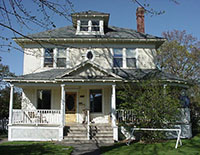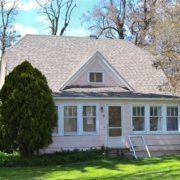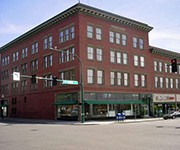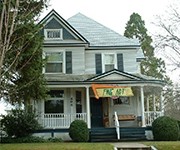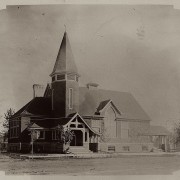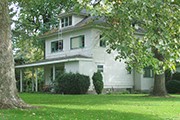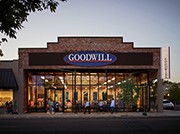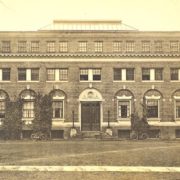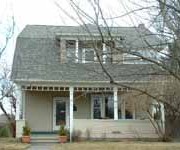History of 104 Merriam Street, Walla Walla, WA – Global Awareness House, Whitman College
Property Description:
College Addition to the City of Walla Walla, East 100 feet of Lot 1, Block 2, Parcel 360720590201.
Title History:
Washington Territory was created in 1853. The new legislature created Walla Walla County in 1854 which stretched from the crest of the Cascade Mountains to the crest of the Rocky Mountains in the present states of Washington, Idaho and Montana. In 1855 an Indian council was held on the banks of Mill Creek at the present site of Walla Walla to purchase land from the Indians. The Yakima, Cayuse and Walla Walla tribes were dissatisfied with the treaties and war followed. Missionaries, former French-Canadian employees of the Hudson’s Bay Company trading post at Wallula, and soldiers at the military Fort Walla Walla were the primary European occupants of the area prior to 1859 when it was opened for settlement. The U. S. Government, in a treaty signed on June 9, 1855 in Walla Walla and ratified on March 8, 1859 by President James Buchanan, acquired all of the land in the Walla Walla area from the Cayuse and Walla Walla Indian tribes.
Walla Walla was originally laid out by County Surveyor H. H. Case in 1859, before its formal incorporation as a city in 1862, as a one-quarter mile square with its eastern side centered on the point where Main Street crossed Mill Creek (at roughly the point where it does now). The City of Walla Walla received a Trustee Townsite from the U. S. Government which consisted of 80 acres issued on July 20, 1869 by the Vancouver, W.T. District Land Office. Main Street originally followed the old Nez Perce Indian Trail. Consequently the streets leading off of it were at right angles to it, and were not in a north-south orientation. This was corrected as the city moved eastward which gave Walla Walla its peculiar street pattern with the three street intersection at Palouse, Boyer and Main Streets. To the original plat, additional parcels were annexed from time to time, usually with the name of the land owner of record at the time the additions were made.
The first patent holders of this southeast quarter of the northeast quarter of Section 20, Township 7N, Range 36E were Mary and William Johnson and John McComb. They acquired this land from the U. S. government under the Script Warrant Act of 1855. It would have been registered in the Vancouver Land Office where additional conveyances would also have been recorded before there was a land office in Walla Walla. The first local entry in the legal title to this property was on January 1, 1862 when a Quit Claim Deed was signed by William H. and Elizabeth Ann Patten that transferred this property (and more, for a total of 40 acres) to Dorsey Syng Baker for $600. This original deed is in the Baker Collection in the Whitman Archives.
Dorsey Baker moved to Walla Walla in 1861 and built a home on the north side of Boyer Avenue on College Creek. He also donated four acres of this 40-acre parcel on the south side of Boyer Avenue to Whitman Seminary. In 1862, Baker was on the City Council and some years later was a Walla Walla County Commissioner. He was the founder of Walla Walla’s Baker Boyer Bank and builder of the first railroad in the valley and the territory. Dr. Baker died in 1888, but his will stipulated that his property could not pass to his heirs before 1900, so his estate was operated for 12 years by his extended family. The executors of his estate had College Addition platted on December 20, 1899.
A Warranty Deed from Miles C. Moore, Henry C. Baker and Walla Walla Willie Baker, executors of the Last Will and Testament of Dorsey S. Baker, deceased, to Baker Loan & Investment Company for $10,000 was executed on February 8, 1900. On March 9, 1905 Baker and Baker sold this property to William M. Van Patten for $531.50. On December 19, 1905 William signed a warranty deed on this property to his wife Rose. William Van Patten had graduated from Whitman College in 1890. He had built the house at 605 Boyer in 1901 (see that history at http://www.wallawalla2020.org/historic/reports/605_Boyer.htm) and later built two other houses for which he took out building permits in 1909 and 1910. He was a physician with offices first in the Reynolds Building, followed by the Denny Building and the Baker Building. On March 24, 1916 Dr. and Mrs. Van Patten sold this property to Samuel J. Smith. In 1919 the City of Walla Walla signed a Quit Claim Deed to Mr. Smith for 10 feet of Merriam Street which it had vacated. On September 21, 1925 Samuel J. and Nora S. Smith sold this property to Carrie M. Dorothy, a widow. On September 1, 1936 Carrie Dorothy sold to George W. and Belle Gluck. On April 30, 1952 Gluck sold to Max K. and Geraldine B. Tysor for $9000. On January 12, 1955 Tysors sold to Charles J. and Florence Monahan for a stated amount of $10. On November 16, 1977 this house was valued at $19,730 following the death of Florence Monahan. On December 16, 1991 Charles Monahan sold this fine house to Whitman College.
Occupant History:
In 1902 Dr. and Mrs. Van Patten lived at 605 Boyer but by 1905 they had constructed and were listed as residing in this substantial home for themselves in one of Walla Walla’s premier neighborhoods. In 1911-1912 Dr. Van Patten’s brother, The Reverend John C. Van Patten, lived with them while he was the pastor of the First Cumberland Presbyterian Church. His usual church was in Dayton but he helped out the Walla Walla church while they were without a regular preacher. Dr. and Mrs. Van Patten lived here until 1916. Following the Van Pattens, Samuel J. and Nora Smith lived here. He was a farmer. Carrie M. Dorothy lived here from 1929 until 1936. She was the widow of W. W. Dorothy. In 1933 she rented out a room to Mrs. Alice Culver, a beauty operator at Dickey’s Shop. In 1936 Mrs. Dorothy worked as a saleswoman at Gardner and Co. George Gluck, a farmer, and his wife Belle lived here from 1937 until 1951 when they moved to 11 Newell Street. The house on Merriam was vacant in 1952 until Max and Geraldine Tysor moved into it. Mr. Tysor was chief of real estate for the Army Engineers. In 1956 Charles J. and Florence E. Monahan moved into this home. Mr. Monahan was a geologist with the Army Engineers (Corps of Engineers). His wife died in 1977 but he continued to live here until he sold this house to Whitman College in 1991 for use as the Global Awareness Interest House. The house was first occupied by Whitman students, Laura Buffo, Laurie Manghelli, Jodi Bunnell and Sarah Hashimoto in 1992.
Construction of the Building:
The Walla Walla County Tax Assessor’s office lists a construction for this house of 1900. However, this research shows that Dr. William M. Van Patten built and occupied this house in 1905, following his purchase of the property in March of that year. The footprint of the house is also on the 1905 Sanborn Fire Map. Therefore the correct construction date is 1905. No building permit exists for this house. However, Dr. Van Patten received a permit for a half-story frame cottage behind this house in 1908 for $2500 and for $100 garage in 1909.
References:
Bennett, Robert A., Walla Walla Portrait of a Western Town 1804-1899, Pioneer Press, Walla Walla, 1980.
Bennett, Robert A., Walla Walla A Town Built to be a City 1900-1919, Pioneer Press, Walla Walla, 1982.
Building Permits: Whitman College Penrose Library Archives.
Sanborn Fire Maps: 1884-1905 (with updates until 1950).
Walla Walla City Directories: 1880-present (various publishers–not all years).
Whitman College Archives.
Whitman College Catalogue, 1901.
Mary E. Meeker Walla Walla 2020 Research Service PO Box 1222, Walla Walla WA 99362 May 5, 2013

